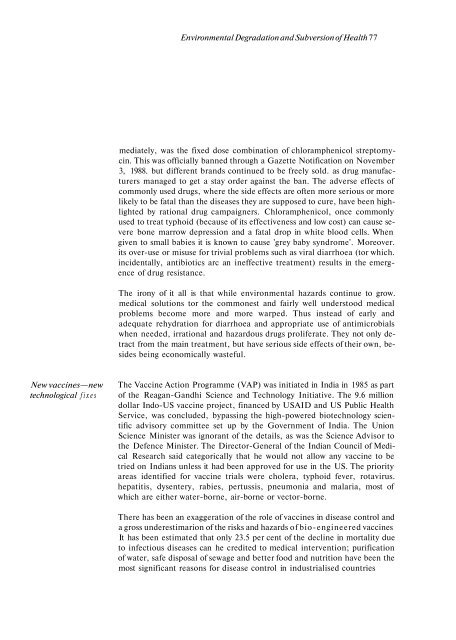Environmental Degradation and Subversion of Health - Dag ...
Environmental Degradation and Subversion of Health - Dag ...
Environmental Degradation and Subversion of Health - Dag ...
You also want an ePaper? Increase the reach of your titles
YUMPU automatically turns print PDFs into web optimized ePapers that Google loves.
New vaccines—new<br />
technological fixes<br />
<strong>Environmental</strong> <strong>Degradation</strong> <strong>and</strong> <strong>Subversion</strong> <strong>of</strong> <strong>Health</strong> 77<br />
mediately, was the fixed dose combination <strong>of</strong> chloramphenicol streptomycin.<br />
This was <strong>of</strong>ficially banned through a Gazette Notification on November<br />
3, 1988. but different br<strong>and</strong>s continued to be freely sold. as drug manufacturers<br />
managed to get a stay order against the ban. The adverse effects <strong>of</strong><br />
commonly used drugs, where the side effects are <strong>of</strong>ten more serious or more<br />
likely to be fatal than the diseases they are supposed to cure, have been highlighted<br />
by rational drug campaigners. Chloramphenicol, once commonly<br />
used to treat typhoid (because <strong>of</strong> its effectiveness <strong>and</strong> low cost) can cause severe<br />
bone marrow depression <strong>and</strong> a fatal drop in white blood cells. When<br />
given to small babies it is known to cause 'grey baby syndrome'. Moreover.<br />
its over-use or misuse for trivial problems such as viral diarrhoea (tor which.<br />
incidentally, antibiotics arc an ineffective treatment) results in the emergence<br />
<strong>of</strong> drug resistance.<br />
The irony <strong>of</strong> it all is that while environmental hazards continue to grow.<br />
medical solutions tor the commonest <strong>and</strong> fairly well understood medical<br />
problems become more <strong>and</strong> more warped. Thus instead <strong>of</strong> early <strong>and</strong><br />
adequate rehydration for diarrhoea <strong>and</strong> appropriate use <strong>of</strong> antimicrobials<br />
when needed, irrational <strong>and</strong> hazardous drugs proliferate. They not only detract<br />
from the main treatment, but have serious side effects <strong>of</strong> their own, besides<br />
being economically wasteful.<br />
The Vaccine Action Programme (VAP) was initiated in India in 1985 as part<br />
<strong>of</strong> the Reagan-G<strong>and</strong>hi Science <strong>and</strong> Technology Initiative. The 9.6 million<br />
dollar Indo-US vaccine project, financed by USAID <strong>and</strong> US Public <strong>Health</strong><br />
Service, was concluded, bypassing the high-powered biotechnology scientific<br />
advisory committee set up by the Government <strong>of</strong> India. The Union<br />
Science Minister was ignorant <strong>of</strong> the details, as was the Science Advisor to<br />
the Defence Minister. The Director-General <strong>of</strong> the Indian Council <strong>of</strong> Medical<br />
Research said categorically that he would not allow any vaccine to be<br />
tried on Indians unless it had been approved for use in the US. The priority<br />
areas identified for vaccine trials were cholera, typhoid fever, rotavirus.<br />
hepatitis, dysentery, rabies, pertussis, pneumonia <strong>and</strong> malaria, most <strong>of</strong><br />
which are either water-borne, air-borne or vector-borne.<br />
There has been an exaggeration <strong>of</strong> the role <strong>of</strong> vaccines in disease control <strong>and</strong><br />
a gross underestimarion <strong>of</strong> the risks <strong>and</strong> hazards <strong>of</strong> bio-engineered vaccines<br />
It has been estimated that only 23.5 per cent <strong>of</strong> the decline in mortality due<br />
to infectious diseases can he credited to medical intervention; purification<br />
<strong>of</strong> water, safe disposal <strong>of</strong> sewage <strong>and</strong> better food <strong>and</strong> nutrition have been the<br />
most significant reasons for disease control in industrialised countries
















